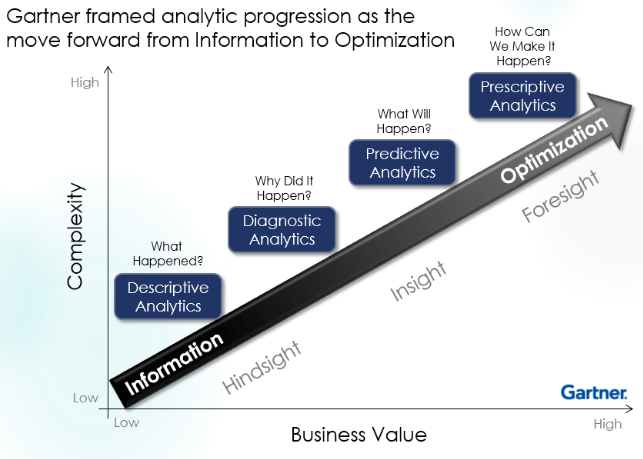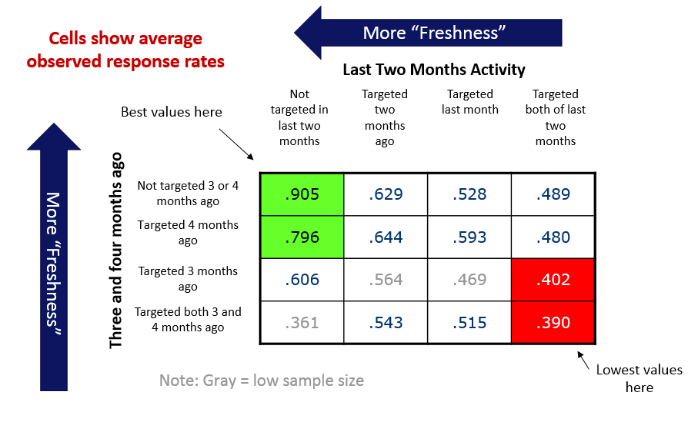It’s an exciting time to work with technology. Daily, it seems there’s a new tool or approach released that enables us, the people working with data, to do our jobs better. One of the powerful approaches we focus on is predictive analytics. This approach isn’t exactly new—we’ve been in the business for years. But, it has become more accessible. This, combined with the quest for optimization, creates a powerful duo for business analysts hoping for better results from their data.
In this post, we dive into predictive analytics and explore how combining predictive models, predictive optimization, and constrained optimization techniques allow marketers and analysts to make better decisions and improve efficiency.
As with most things, when analyzing data, the correlation between complexity and value is clear and well illustrated in Gartner’s analytic progression, above. In the context of business, there is an increased opportunity for optimization as more data is collected. This allows businesses to use data not just in hindsight after a campaign is finished—Descriptive Analytics, but instead, to predict how to drive future behaviors—Prescriptive Analytics. This provides a huge opportunity to leverage data to create desired outcomes. Gartner’s progression above illustrates the relationship between Complexity and Business Value and the journey from information to optimization.
For the purpose of this post, we will focus on the power of Predictive Analytics and Prescriptive Analytics.
Predictive Analytics and Prescriptive Analytics are two separate approaches for analyzing data. On their own, each can be beneficial for an organization, but the power comes when you combine them. Predictive Analytics helps you to determine the likely outcome of unknown future events. This allows organizations to optimize marketing campaigns, reduce risk, and improve inventory management. Prescriptive Analytics helps to manage the market fluctuations you might have predicted and the potential business implications of consumer responses and behaviors.
Combining these two methods creates a Predictive Optimization Model that incorporates marketing tactics into the predictive model. With this combination, you can explore the potential future of the market in the context of marketing tactics to drive the desired behavior. You can explore outcomes of variables, such as:
- Offer types
- Offer values
- Discounts
- Messaging
- Sequencing
- Channels
To take this one step further, let’s talk about the Constrained Optimization model. These models incorporate hard constraints into the model so you can get a clearer understanding of how market situations like budgets or seasonality might affect your business. Viewing data through this lens allows you to compare and contrast marketing approaches and determine which will have the most impact. This saves money, time, and resources.
An example of this type of model is below. These charts explore the elasticity curves for a consumer when offered a discount, hotel credit, or miles. As it shows below, there is a clear optimal amount to offer customers for the highest possible expected profit for an organization.
Another example of using a Predictive Optimization Model for decision making is below. In this instance, an organization is using recency and frequency to incorporate cadence into the model. This tells an organization the best possible time to reach out to a particular audience in order to get the best results, shown in green.
When and How to Consider Constraints
Constraints make the overall approach more complex. However, it’s often important to account for them—failing to can leave significant weaknesses in your approach and the results. Not considering real limitations to your campaign does your organization a disservice. So, here are some recommendations on how to think about constraints, the number and complexity of constraints determine the solution:
| Dimensions | Constraints | Solution | Example |
| 0 | 1 (total budget) | Rank order all | Overall marketing budget |
| 1 (channel) | 1 (total budget) | Rank order by dim | Marketing budget by channel |
| 1 (channel) | 2 (channel & budget) | Rank order by dim | Channel max spend and min spend |
| 2+ | 2+ | Harder!
Need tools |
Channel max spend with product min performance + more |
As you can see, the more constraints and dimensions that exist, the more complex it is to use constrained optimization. However, marketing teams that are empowered with these tools are able to improve prediction and engagement with prospects and customers and increase the profitability of the organization.
To put this information in context and illustrate the approach and impact of constrained optimization, we have a case study to share.
Case Study: Retail Direct Mail Targeting Optimization
In this campaign, we aimed to maximize the overall response rate of a direct mail campaign for an organization.
For this, each prospect had a predictive model score based on:
- Demographics (age, income, education)
- Location (distance, drivetime to closest store)
- Appended behaviors (credit card usage, internet usage)
This was considered with the following constraints:
- Meet store minimum quantity needs
- Cross-decile testing and metrics
- Prior times targeted
- Cadence is (currently) controlled in this case study through constraints – not incorporated yet into a modeling paradigm.
Understanding this data allowed the client to better predict and engage with consumer markets. Implementing modeling and constraints under these conditions helped generate incremental sales consistently since the program began mid-July 2014.
Want to learn more about advanced analytics and optimization? Read more here.





